OLD NEWS >> September - November 2005
2005-11-29 Young people do not like to move their body
At my job as a substitute teacher at primary school I teach most of
the ordinary subjects like Swedish, maths, natural science etc and sometimes
I am also responsible for physical education lessons
for kids/young people from the age of 10 to 15. You might think it is
the easiest subject to teach since I have a lot of experience from various
sports and also because kids usually like PE more than other subjects.
The truth is that it's actually a big challenge to get the pupils moving
a bit. Many of them are in a very poor shape and they try to find every
possibility to skip the PE or to get through the lessons with as little
effort as possible. The older the pupils are, the worse condition and
attitude to training they have. According to my experiences boys are often
less motivated and less fit than girls.
About a week ago I got disappointed after I tried to carry out a kind
of an easy strength training with two classes of 15-years-old pupils.
In the beginning of the lesson many of them came with different excuses.
The most common one was: "I have forgotten my sport clothes"
followed by: "I have pain in ..." or "I have been ill recently"
etc. Also to see how week most of the remaining pupils were during the
strength training was no fun at all.
I have read several articles about the decreasing physical activity and
health of young people in Sweden. In one report
from Swedish National Institute of Public Health it is mentioned that
over the last 15-20 years overweight and obesity have doubled in the 10-24
age group.
I have been asking myself many times what to tell those young people,
how to convince them that it is a great fun to train and how to get them
care more about their health.
Do you have any suggestion?
2005-11-18 AR world championship
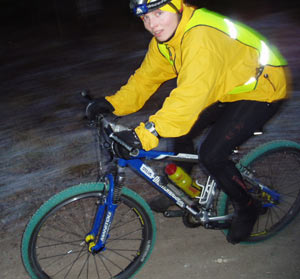 This
week Adventure Racing World Championship is being held in New Zealand.
The race started on Monday and today the first team - Balance Vector -
crossed the finish line. Four strong Swedish teams (Cross Sportswear,
Halti, Lundhags Adventure and Herkules) came to New Zealand to fight for
the medals. At this moment Halti and Cross Sportswear are still on the
course not very far from the finish. Lundhags Adventure and Herkules have
withdrawn. I was happy to see also one team from Czech republic among
the participants. I think it is the first time a Czech team takes part
in such a big adventure race. The course is over 400 km long and disciplines
are trekking, MTB, kayak paddling, white water rafting, caving and rope
works. Trekking has been the decisive discipline. Bushy terrain and difficult
navigation has been a real challenge for all of the teams. I have spent
a lot of time following the race via Internet. See the site of AR
World Championships with the course description, photos, teams, results
etc.
This
week Adventure Racing World Championship is being held in New Zealand.
The race started on Monday and today the first team - Balance Vector -
crossed the finish line. Four strong Swedish teams (Cross Sportswear,
Halti, Lundhags Adventure and Herkules) came to New Zealand to fight for
the medals. At this moment Halti and Cross Sportswear are still on the
course not very far from the finish. Lundhags Adventure and Herkules have
withdrawn. I was happy to see also one team from Czech republic among
the participants. I think it is the first time a Czech team takes part
in such a big adventure race. The course is over 400 km long and disciplines
are trekking, MTB, kayak paddling, white water rafting, caving and rope
works. Trekking has been the decisive discipline. Bushy terrain and difficult
navigation has been a real challenge for all of the teams. I have spent
a lot of time following the race via Internet. See the site of AR
World Championships with the course description, photos, teams, results
etc.
The photo here is taken during today's MTB-training.
I try to train biking 1-2 times/week as long as there is not enough snow
for skiing.
2005-11-06 Cross-country running
Last Saturday I participated for the first time in a cross-country race
in Sweden. It was a 10,3 km long race in Örebro called
Kilsbergsleden. A few weeks ago I made a decision to take part in
several races like this during the coming months. Not because I think
competing in cross-country running is so much fun but because I believe
that it is a good training and a way how to became faster.
I think I had a good run on Saturday. At least I pushed hard and made
myself pretty tired. In the evening I got a headache and felt sick, probably
because of the race. Luckily, I felt fine again on Sunday morning. Results
(class "Ksen").
Last week the Czech national team in orienteering for next season was selected. I am one of the six women in the team. See also my new training diary (written from 2005-10-31).
2005-11-01 More scanned maps
I have added almost 20 maps I have used for my training this year. See maps. Some of them are with my route but not all of them.
2005-10-31 New "training year" starting
Yesterday it was the last day of the training year 2004/2005. During
the last weekend I spent some time analyzing my
training diary (excel-file 374KB) and thinking how to improve my training
for the coming year. Here is a short summary of my training (November
1, 2004 - October 30 2005):
287 days of training and 337 training sessions
40 races (30 o-races, 4 xc-skiing marathons, 4 ski-o, 1 xc-running, 1adventure
race)
56 days of limited training because of illness/injury (most of the days
due to my toe injury in August/September)
420 hours of training totally
213 hours of all kinds of running (64h with map included)
207 hours of something else than running (95h xc-skiing, 60h MTB, 35h
other activities -kayak and aerobics, 17h strength)
420 hours is not much. I guess that the best o-women train about 600 hours/year and some even more. It is obvious that if I want to be a better orienteer next year, the first change must be to increase the number of training hours. However I do not think that one should focus too much on the amount of training (might it be hours or kilometers). It is more important to know the purpose of every training session than to train with a goal of reaching a certain number of hours every week. Almost half of my training was alternative (= something else then running). One of the reasons is that I did too little running in 2002-2004 (when I trained for adventure racing and worked full time during certain periods). Too big increase of the running part of my training in 2005 would not be good for my body (risk for injuries etc.). Another reason for so much alternative training is that I enjoy xc-skiing, biking and kayaking a lot and it is often more fun to train than running. I can also train much more if I train all these different sports and not only running. For example I know that 1-1,5 hours of biking in the afternoon/next day after a hard running training (intervals, tempo, up-hill) often helps my legs to recover better than if I went for jogging or had a complete rest.
During the past season I participated only in 30 o-races. It is probably less than most of the other elite runners. Each race requires a lot of mental energy. I am convinced that I have to keep the number of races low in order to be able to concentrate properly during each race. Also my training would suffer if I competed too much. If I competed every weekend then I would have to reduce both the quality and quantity of the training. I am going to have the same approach also the next year.
So what are the plans?
I want to train more (number of hours), especially running, but the main
focus must be on quality. From November to February I want to have at
least two "quality" training sessions every week. Those can
be either some kind of intervals (flat or hilly, even on skis or bike)
or a tempo (fast run 20-40 minutes in a steady pace). I keep in mind that
WOC in Denmark is in a hilly terrain so a great part of my training will
be in a hilly terrain as well. I also want to include more plyometric
exercises (in Swedish "spänst" - which means various kinds
of jumps) and also running drills ("löpskolning).
2005-10-24 Winter is here
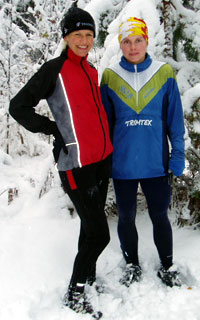 It
was snowing a lot here in Borlänge during the last weekend. Now the
temperature outside is -5 degrees Centigrade and it looks like it is middle
of December...
It
was snowing a lot here in Borlänge during the last weekend. Now the
temperature outside is -5 degrees Centigrade and it looks like it is middle
of December...
It is not very common that we get so much snow in Borlänge already
in October. However, there is no big chance that we could start with cross
country skiing now and it is quite sure that the snow melts down in a
few days. The photo is taken after a long run with Karolina and Patrik
on Sunday morning.
I like winter and and I hope we are going to have a lot of snow this time.
The last winter was a disaster. Vasaloppet could be held only because
an enormous effort was made to create artificial snow and to transport
natural snow from the mountains in order to cover the whole track of 90
km. Many other cross-country skiing and ski-o races had to be cancelled.
Despite the lack of snow I managed to carry out a great part of my training
on skis (about 90 hours/1300km). This winter I plan to ski even more but
I want to concentrate more on quality training (intervals and skiing in
hilly terrain) and not only to use cross-country skiing for "collecting
hours" in my training diary.
I have experienced very different winters here in Borlänge. The last
one with the huge lack of snow was very unusual. I remember that I was
training orienteering in January a few times. There was almost no snow
in the forest. However, the common situation is that it is possible to
practice cross-country skiing more or less from December until middle
of March. We can have a lot of snow still lying in the forest in the middle
of April which is not so great because orienteering season starts already
at the end of March.
Most of the orienteers living in this area are like me - they train a
lot of cross - country skiing in the winter. I think it is more fun than
running on bicycle paths and roads, or trying to run in the deep snow
in the forest. Of course, you cannot stop running completely but I usually
reduce the number of running training sessions to 2-3 per week if the
skiing conditions are good. This winter I want to train more often in
the indoor track in Falun (200m track) with a group of athletes from the
university. Many orienteers are afraid of injuries and they avoid running
indoor, but I have never had any problems there. I have also done running
on treadmill. It might be the only possibility to run fast if the temperature
outside is -10 degrees or lower and the indoor track is closed. Actually
there is another way how to prevent cold air from coming into your lungs.
I have seen two different models of a "mouth heat/moisture exchangers"
in Sweden, one is called lungplus
and the other one airtrim.
It looks a bit funny but it helps many people, especially those with asthma,
to train outside in the winter. During winter I also train spinning once
a week or once a two weeks and strength one or twice a week.
 Few
days ago the Czech Orienteering Federation published the embargoed
areas for WOC 2008. Some of the areas are pretty large. Two of them
(number 1 and 2) are intended for sprint and are located in centrums of
two big cities - Olomouc and Prostejov. The WOC -center is going to be
located in Olomouc. I have trained and/or competed in about half of the
areas. The area number 8 Hady-Ricky was my "home-forest" during
10 months in 1998-1999 when I lived in Brno. Hmmm... The terrain in the
different areas varies a lot but if I try to find a common description
then it would be "hilly", except for the sprint areas in Olomouc
and Prostejov. There are no sandstone rocks in any of those areas. Few
of the areas are located in mountains. I think the WOC 2008 will be technically
and especially physically demanding.
Few
days ago the Czech Orienteering Federation published the embargoed
areas for WOC 2008. Some of the areas are pretty large. Two of them
(number 1 and 2) are intended for sprint and are located in centrums of
two big cities - Olomouc and Prostejov. The WOC -center is going to be
located in Olomouc. I have trained and/or competed in about half of the
areas. The area number 8 Hady-Ricky was my "home-forest" during
10 months in 1998-1999 when I lived in Brno. Hmmm... The terrain in the
different areas varies a lot but if I try to find a common description
then it would be "hilly", except for the sprint areas in Olomouc
and Prostejov. There are no sandstone rocks in any of those areas. Few
of the areas are located in mountains. I think the WOC 2008 will be technically
and especially physically demanding.
2005-10-10 25-manna: my last orienteering race of this year
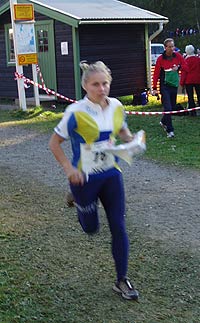 25-manna
is a huge but a bit special relay race for teams of 25 runners from the
same club. The 1st, 2nd and the last 3 legs (23rd, 24th and 25th) are
run as in a normal relay race while the 4th-7th legs are parallel legs
with 4 runners on each of them. Each team consists of both men and women,
young and old runners and there are special rules about who is allowed
on each leg. For example no D19-34 or H15-49 is allowed on the 23rd leg,
only women are allowed to run the 3rd and 24th leg etc. The team is made
up of a maximum of 9 H21-39s runners and at least 7 women must be in each
team. The last 3 legs are without any gafflings. 25-manna is always held
in Stockholm area. Swedish teams are in majority but there is also a great
number of Finnish and Norwegian teams participating. About 340 teams started
in this year's race and it was won by Kalevan Rasti from Finland. I actually
have one 25-manna victory - it is from 1999 when I competed for IFK Lidingö
from Stockholm.
25-manna
is a huge but a bit special relay race for teams of 25 runners from the
same club. The 1st, 2nd and the last 3 legs (23rd, 24th and 25th) are
run as in a normal relay race while the 4th-7th legs are parallel legs
with 4 runners on each of them. Each team consists of both men and women,
young and old runners and there are special rules about who is allowed
on each leg. For example no D19-34 or H15-49 is allowed on the 23rd leg,
only women are allowed to run the 3rd and 24th leg etc. The team is made
up of a maximum of 9 H21-39s runners and at least 7 women must be in each
team. The last 3 legs are without any gafflings. 25-manna is always held
in Stockholm area. Swedish teams are in majority but there is also a great
number of Finnish and Norwegian teams participating. About 340 teams started
in this year's race and it was won by Kalevan Rasti from Finland. I actually
have one 25-manna victory - it is from 1999 when I competed for IFK Lidingö
from Stockholm.
Our club Domnarvets GoIF had only one team and still it was not an easy
task to gather 25 runners of right age and sex. Many phone calls were
made during the last week... 25-manna is not an important race for our
club but it is still fun to compete together with so many others. I got
the 24th (second last) leg. When I started our team was on 98th place
and when I came to the change-over 36 minutes later we were 81st. Still
I am not very satisfied with my run. It took a while to find the right
speed and concentration. There were many paths in the terrain and it was
easy to continue in the same speed even after leaving them. A few times
I did not manage to slow down enough and lost time at some controls especially
in the beginning of the race. See my
map. The best time on my leg was 32 minutes. I ran in VJ Sarva shoes
and not in my normal orienteering shoes in order to protect my painful
toe. It is slowly getting better. I read about this kind of injury (toe
fracture) and found that it could easily take 6 weeks to heal. It is about
7 weeks since WOC and my little toe is not completely OK. At least I can
train almost without restrictions now.
Our team finished 79th which is almost the same result as in the last
year.
See also 34
pictures from 25-manna.
Results.
2005-10-05 Plans for the next year
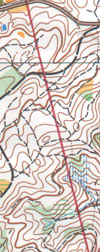 After
WOC in August I started to think about my plans for the next year. Should
I concentrate on orienteering again and try to prepare for WOC
2006 in Denmark? Or should I give priority to finding a proper job?
After
WOC in August I started to think about my plans for the next year. Should
I concentrate on orienteering again and try to prepare for WOC
2006 in Denmark? Or should I give priority to finding a proper job?
If I am looking back at this year's o-season it was better than I expected.
I got selected for the WOC and my results there were better than my results
in the two other WOC I participated in 1999 and 2001. Also the victory
in Tiomila with my club Domnarvets GoIF in May was a great achievement.
I have enjoyed orienteering a lot this year.
The next year's WOC in Denmark is held in my favourite terrain (look at
the map here on the left side). I am convinced that I can run even better
there than I did in Japan.
Why do I have doubts about the next year then? The reason is that it is
difficult to manage with the little money I make in my job. Since the
beginning of this year I have been working as a substitute teacher at
primary schools in Borlänge. I do not have any job-contract. I work
only when that schools need me - when one of their ordinary teachers is
sick or on a vacation. Some days I know at which school I am going to
work and which subject I am going to teach but some other days I only
receive a telephone call between 7 and 8 a.m. telling me where and what
I should teach that day. To be flexible is quite necessary... I work 80-90%
of all working days, usually from 8 a.m. until 14-16 p.m. and I am paid
by hour. If I am going to a training camp or have an exam at the university
I only inform the schools that I am not available at the particular day/days.
I like working with kids more then working with money even if I have an
university degree from business administration and not from pedagogy.
However, sometimes the teaching is quite tiring and I need a lot of discipline
to get myself out and train in the evening . At the same time I learn
more at my work then I have ever learnt during my university studies.
I am sure that many other orienteering runners have similar thoughts.
It is not easy to combine working and elite orienteering. To participate
in World Champs, World Cup and a few training camps and to work full-time
at the same time is possible only if you sacrifice a lot of other "activities"
in your life. To find a part-time job in Czech republic is almost impossible
and some of the members of the Czech national team simply have to concentrate
on working and give up orienteering.
I hope that I can manage the next season with some help from my boyfriend
and my Swedish club. I have made decision to go for the next year's WOC
in Denmark.
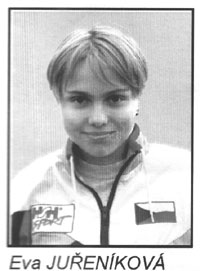 I
have many nice memories from Denmark. I participated in my first JWOC
here in 1995 (see the picture to the left - it is from the Czech team's
presentation brochure). It was probably my most successful JWOC even if
I was only 16 years old then. I was the last-leg-runner in the relay team
who won the gold medal and I finished 10th in both classic distance and
short distance. JWOC 1995 was held in the the same area as the next year's
WOC - in the forests near Silkeborg. I took out my maps from the JWOC
1995 and from Euromeeting 1994 which was also organized in the same area.
I like the terrain - it is rather hilly but fast with easy orienteering.
Route choices will be important again which I like. I know that I have
to become a faster runner if I want to succeed next year. I decided to
start to compete in cross-country running and generally train more running
and some specific strength. I have scanned my old maps from Denmark:
I
have many nice memories from Denmark. I participated in my first JWOC
here in 1995 (see the picture to the left - it is from the Czech team's
presentation brochure). It was probably my most successful JWOC even if
I was only 16 years old then. I was the last-leg-runner in the relay team
who won the gold medal and I finished 10th in both classic distance and
short distance. JWOC 1995 was held in the the same area as the next year's
WOC - in the forests near Silkeborg. I took out my maps from the JWOC
1995 and from Euromeeting 1994 which was also organized in the same area.
I like the terrain - it is rather hilly but fast with easy orienteering.
Route choices will be important again which I like. I know that I have
to become a faster runner if I want to succeed next year. I decided to
start to compete in cross-country running and generally train more running
and some specific strength. I have scanned my old maps from Denmark:
Silkeborg Nordskov
(Euromeeting 94 clas. distance + results
D20) - WOC training area
Silkeborg Vesterskov
(Euromeeting 94 relay) - WOC training area
Grund (JWOC 95 short
distance)
Velling - Snabegård
(JWOC 95 classic distance)
Rye Sønderskov
(JWOC 95 relay) - embargoed area - reserve
Links:
WOC 2006
JWOC
1995 (with all results and maps with courses)
On Saturday our club participates in 25-manna (relay with 25 runners in one team) in Stockholm. We do not have any big ambitions but it will be fun. I have started to run again but on asphalt only - then I can run without having pain. Yesterday I ran intervals for the first time since WOC.
2005-09-26 A lot of biking last week
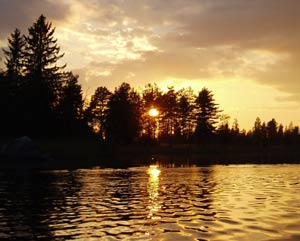 After
the Swedish champs I decided to avoid running as long as my little toe
would hurt in order to give the toe chance to heal. Last week I did a
lot of cycling, most of it in hilly terrain and on small paths. Yesterday
I and Patrik were cycling along Finnmarksturen trail. Finnmarksturen
is the biggest MTB-race in Sweden, held every year at the end of August.
Patrik has participated couple of times but I have never done it. The
trail is 112 km long and consists of single tracks, gravel roads and very
little paved roads. Both the start and finish are situated in Ludvika,
40 km S from Borlänge. The trail is not marked so it might be difficult
to find it unless you have ridden Finmarksturen a few times before. It
took us little bit over 6 hours, inclusive a few small breaks and problems
with finding the trial. Check the
map with the whole track (pdf) and profile.
After
the Swedish champs I decided to avoid running as long as my little toe
would hurt in order to give the toe chance to heal. Last week I did a
lot of cycling, most of it in hilly terrain and on small paths. Yesterday
I and Patrik were cycling along Finnmarksturen trail. Finnmarksturen
is the biggest MTB-race in Sweden, held every year at the end of August.
Patrik has participated couple of times but I have never done it. The
trail is 112 km long and consists of single tracks, gravel roads and very
little paved roads. Both the start and finish are situated in Ludvika,
40 km S from Borlänge. The trail is not marked so it might be difficult
to find it unless you have ridden Finmarksturen a few times before. It
took us little bit over 6 hours, inclusive a few small breaks and problems
with finding the trial. Check the
map with the whole track (pdf) and profile.
On Saturday evening we went for a kayak trip from Toftbyn to Svärdsjö
and back. It was one of my best paddling experiences ever. The nature
around the lakes, autumn colours, sunset... It was great!
See pictures
from the paddling and MTB-ride along Finnmarksturen trail.
2005-09-21 Two days full of activities with the university sports group in Säfsen
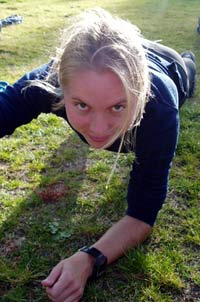 Since
the beginning of this year I have been member of "Idrottshögskolan"
= university sports group at Dalarna University (Högskolan Dalarna).
Members of this group are students who want to combine elite sport and
studies. Even if I have been working most of the time as a substitute
teacher I have also been a part-time student. In spring I studied a course
called "Tests for Athletes -Strength, Flexibility and Motor
Skills" and this autumn I have just started to attend "Sports
Medicine for Athletes". Both of the courses are web-based,
which means that it is possible to follow the lectures via Internet. I
really appreciate this way of learning. I can sit at home and watch the
video from the lecture when it suits me. I can also stop it or watch it
more times if I missed something. On the other hand I understand that
it is not so much fun for the teachers to hold a lecture only for a camera,
without any immediate feedback. During the course the teachers and students
meet also 2-3 times in Falun to devote a whole day to more practical parts
of the course. There is a special web site for the course with many interactive
functions like forum and chat. Both courses are in Swedish. If you want
to know more check this site.
Since
the beginning of this year I have been member of "Idrottshögskolan"
= university sports group at Dalarna University (Högskolan Dalarna).
Members of this group are students who want to combine elite sport and
studies. Even if I have been working most of the time as a substitute
teacher I have also been a part-time student. In spring I studied a course
called "Tests for Athletes -Strength, Flexibility and Motor
Skills" and this autumn I have just started to attend "Sports
Medicine for Athletes". Both of the courses are web-based,
which means that it is possible to follow the lectures via Internet. I
really appreciate this way of learning. I can sit at home and watch the
video from the lecture when it suits me. I can also stop it or watch it
more times if I missed something. On the other hand I understand that
it is not so much fun for the teachers to hold a lecture only for a camera,
without any immediate feedback. During the course the teachers and students
meet also 2-3 times in Falun to devote a whole day to more practical parts
of the course. There is a special web site for the course with many interactive
functions like forum and chat. Both courses are in Swedish. If you want
to know more check this site.
What does it mean to be a member of the university
sports group? The purpose of the whole project is to help
elite sportsmen and sportswomen to combine the sport and studies. There
are 6 groups (orienteering, cross-country skiing/ski-orienteering,
downhill skiing, track & field, cycling and triathlon) and
each group has a couch who organizes training, training camps, is an adviser
for the students and helps in many other different ways. Each group has
a minibus at its disposal and the students also have a free access to
a gym, swimming pool and indoor track. I should also explain that the
members are enrolled at different courses and programs at Dalarna University.
There are many other advantages of being a member of the group. I was
member also in 1999-2002 and this possibility of combining studies and
elite sport was actually the reason why I chose Borlänge and Dalarna
University when I made the decision to move to Sweden.
Last Monday and Tuesday we had a kind of kick-off with the students and
coaches from the university sports group. We went to Säfsen
(apr. 100km SW from Borlänge) where we did some team building activities,
got tips on strength and flexibility exercises and also where we got the
possibility to get to know each other better. I enjoyed the the two days
in Säfsen a lot and I already look forward to a next training camp
which will be in Idre in December.
See the pictures.
Check the site of the orienteering group www.orienteringshogskolan.com
2005-09-19 Relay championships - why so little gaffling?
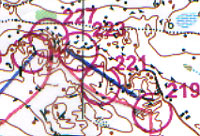 Yesterday
I participated in the last important race of this season - the Swedish
relay championships. Despite the problems with my painful little toe I
decided to run. I got the second leg in our first team with Eva Elfving
on the first leg and Karro on the last one. At the first change-over it
looked really great - all our three teams were in the leading group. I
am satisfied with the first two thirds of the race but the last third
was a disaster. I lost 4-5 minutes at 4 different controls. It was frustrating.
A few times I managed to run away from most of the other women in the
pack but every time they caught me again after my mistakes. What I did
not like about the race was the gaffling system. The gaffling was used
twice!! only at our course (the first 3 controls plus one control at the
second part of the race).
Yesterday
I participated in the last important race of this season - the Swedish
relay championships. Despite the problems with my painful little toe I
decided to run. I got the second leg in our first team with Eva Elfving
on the first leg and Karro on the last one. At the first change-over it
looked really great - all our three teams were in the leading group. I
am satisfied with the first two thirds of the race but the last third
was a disaster. I lost 4-5 minutes at 4 different controls. It was frustrating.
A few times I managed to run away from most of the other women in the
pack but every time they caught me again after my mistakes. What I did
not like about the race was the gaffling system. The gaffling was used
twice!! only at our course (the first 3 controls plus one control at the
second part of the race).
See the gaffling
alternatives D21. Moreover, the gaffling controls were very close
to each other. If you looked around, you were able to see most of them.
The goal of the course setter was to make a very tight race, but I did
not like this way of setting a course at all and I hope that this is not
how relay races are going to be organized in the future. There is a discussion
on this topic on alternativet.
Karro did not have a good run either and finally we finished on the 7th
place. It is a disappointment, especially after our Tiomila victory this
year.
Results
and my map.
SM-relay was the last important race of this season. I am not going to
run the World cup in Italy. Instead I plan to start training for the next
year as soon as I get rid of the pain in my little toe. I have already
decided the goal for next year. I will try to improve my results from
Japan at the WOC in Denmark.
2005-09-13 Too much pain - no final
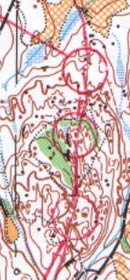 Last
weekend the Swedish championships week started with the long distance
in Smedjebacken. It is actually tougher to make it to the final at Swedish
championships than at WOC. There are 4 heats and 10 bests runners qualifies
for the final. It is the same system as at WOC but there is a greater
number of good runners who run only a bit slowlier than the world´s
best. A few of the Swedish WOCs' participants actually did not make the
final last weekend.
Last
weekend the Swedish championships week started with the long distance
in Smedjebacken. It is actually tougher to make it to the final at Swedish
championships than at WOC. There are 4 heats and 10 bests runners qualifies
for the final. It is the same system as at WOC but there is a greater
number of good runners who run only a bit slowlier than the world´s
best. A few of the Swedish WOCs' participants actually did not make the
final last weekend.
I had a similar tactics as at WOC - to run a bit slowlier that I would
do in the final and to navigate extra carefully. I had a good run apart
from a smaller boom on the way to the second control. See the map.
However, I did not feel well physically. It was no surprise since I have
been running very little since the WOC because of pain in my left little
toe. The pain was not that bad during the race but I got another problem.
My left leg´s hamstrings (back side of thigh) and gluteus muscles
(butt) got very stiff. Immediately after the race I was not able to get
them relaxed and even a slow jogging was impossible. There is an obvious
connection with the painful little toe. In order to avoid the pain I use
a bit different running technique and put an extra strain on some parts
of my body. On Sunday morning I got up early and went for a short run
to test how it feels. The pain in the little toe was much worse and I
finally made a decision not to participate in the final. I would probably
be able to run the whole course, but it would not be fun and the problem
both with the little toe and the stiff muscles would only get worse. So
I stayed at home and followed the race via Internet. It was great to see
Karro winning the race. This week I will run only the relay championships
on Sunday. It is going to be the last important race of this season.
2005-09-05 Worst mistake of this year
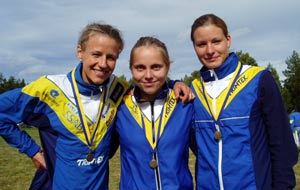 Last
Sunday I participated in the relay district championship in Grangärde.
The most positive thing about the race was that my little toe was better
this time. It seems that I can start to train normally again, after 3
weeks of very little running training.
Last
Sunday I participated in the relay district championship in Grangärde.
The most positive thing about the race was that my little toe was better
this time. It seems that I can start to train normally again, after 3
weeks of very little running training.
I got the second leg as usual. Eva Elfving did a very good performance
on the first leg and came to the change-over in the leading group together
with two other girls. If I had any tactics for this race then it was probably
to "run away" from the other girls and to come to the change-over
in a big lead. Now I realize that it was not a right way to think. I was
not concentrated enough and I did a huge parallel mistake at the second
control. I thought I knew where I was but after same time I did not get
it right. I went some hundred meters back but it did not help. I guess
this mistake cost me about 10 minutes! See the map.
It was for sure the worst orienteering mistake of this year. After the
second control I managed to improve my concentration and my orienteering
was Ok again. I hope I have learned something from the race. Our team
finished third, long after our biggest rivals Stora Tuna and a few seconds
after Leksand. Karro on our third leg was a bit unlucky with longer gaffling
at the very end of the course. See some photos.
Results
>> Old news
